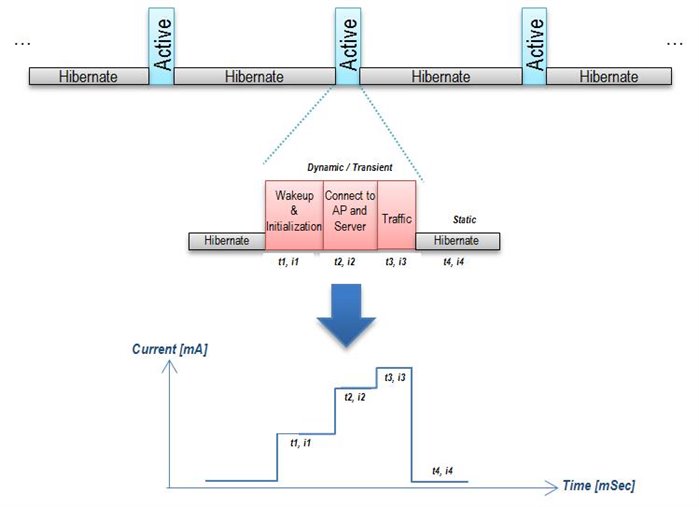SSZTBV7 november 2015 CC3100 , CC3200
Measuring your application’s energy consumption enables you to evaluate your product’s energy lifetime. Wi-Fi® applications require measuring the energy consumption both in inactive low-power (aka static) and in active (aka dynamic) modes, for a single use cycle as well as the entire life span of the system. Therefore, static measurement tools are not enough and more advanced measuring tools are needed. In this post we’ll discuss the various options to measure your application’s energy consumption.
Application Energy Consumption Calculation Background
The application energy consumption profile of a system describes the system’s energy consumption in different operation modes over time. The profile also includes the energy consumed by the transition between the different system modes. The total energy consumed is an integral of the current consumed, measured in units of amperes, over time from the power supply:

Alternatively the charge consumption could be calculated as follows:

Commonly, a simpler, piecewise linear approximation description of energy consumption is used:

Alternatively the charge consumption could be calculated as follows:

The capacity of a battery indicates how much charge it can store. Capacity can be specified by ampere-per-hour rating which is equivalent to charge. The application charge consumption and the battery capacity determines the application life time.
Application Energy Consumption Calculation Example
Every energy consumption use case is combined from a dynamic (transient) part and static part. For example, consider an intermittently connected device, where a sensor wakes up periodically to communicate with a server. When between communications, the sensor is in its lowest power mode (static power mode). The transient energy consumption of this system includes the wakeup, initialization and network activity sequences – during which the sensor associates with the Wi-Fi® access point, connects and communicates with the server on the cloud, and then disconnects and goes back to low power mode. The static energy consumption of this system is manifested when the device is in hibernate mode.

Let’s use the above diagram for calculating the product lifetime for a battery operated sensor, that wakes up once an hour for less than a second to connect and communicate with the server, and then goes right back into hibernate mode for the remainder of the hour.
The wakeup consumes (t1=70mSec, i1=25mA), connects to the AP and the server consumes (t2=500mSec, i2=45mSec), and communicate with the server consumes (t3=2mSec, i3=200mA), and goes back to hibernate mode (t4=~1hour, i4=5uA). The calculation is divided into the dynamic part and static part consumed during a single cycle of one hour:
- The total dynamic energy consumption is 25[mC] including the wakeup, connection and traffic sequences: t1*i1 + t2*i2 + t3*i3 = 70mSec*25mA + 500mSec*45mSec + 2mSec*200mA =~ 25[mC].
- The total static energy consumption is 18[mC] including the hibernate current for one hour approximately: t4*i4 = 1[h]*(60m*60s*1000m)*0.005mA = 18[mC].
- Therefore the total charge for a single cycle is 25+18 = 43[mC = mAS]
Assuming using a battery with a capacity of 1000mAh the lifetime is 9.5 years:
{1000[mAh]/43[mAS]}/24[hours] = {1000*(60*60)[mAS]/43[mAS]}/24[hours] ~= 3500[days] = 9.5[years].
Measuring Your Application Energy Consumption
The SimpleLink™ Wi-Fi device static power modes include hibernate, low power deep sleep (LPDS) and active (receive or transmit). Measuring static power consumption can be done using a digital multi-meter. An easy way to measure static power consumption is described in the following links:
- CC3200 static power consumption measurement using the CC3200 Launchpad™ development kit
- CC3100 static power consumption measurement using CC3100 BoosterPack™ plug-in module
For measuring the application dynamic energy consumption, a more advanced tools should be used e.g. Oscilloscope with a current probe or a communication DC source. Ways to measure dynamic energy consumption are described in the following links:
- CC3200 application power consumption measurement using CC3200 Launchpad development kit
- CC3100 application power consumption measurement using CC3100 BoosterPack plug-in module
Need More Information?
Detailed descriptions of key aspects related to low power networking are available at: SimpleLink Wi-Fi CC3100/CC3200 Internet-on-a-chip™ devices networking sub-system power management
Our low-power Wi-Fi blog series discusses how to optimize an application’s power consumption. In the next post we will discuss how application and environment properties impact the power consumption. We’ll also update the links below as each new blog in the series is posted.